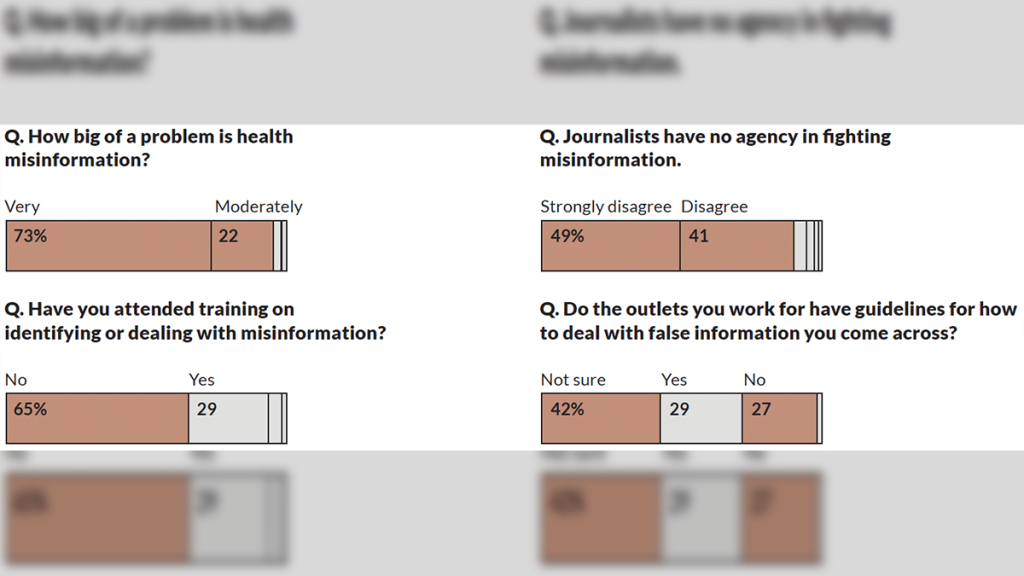
How journalists address misinformation from official sources
Survey of 630 health journalists provides guidance and takeaways
How health journalists manage situations with misinformation
With the U.S. Surgeon General declaring misinformation an “urgent threat” to public health and issuing an advisory in 2021 and the FDA Commissioner Robert Califf in 2022 saying he believes misinformation is the leading cause of death, health journalists have their work cut out for them.
Accurate information is one of the hallmarks of journalism, and health journalists were at the forefront of educating their audiences with the most up-to-date and relevant information during the pandemic.
In the Spring of 2023, the Reynolds Journalism Institute funded research to survey roughly 630 health journalists about misinformation and other health topics.
More training is needed
Around 90 percent of the surveyed journalists disagree with the statement that there is little to nothing they can do to fight misinformation. Even though they are not ready to throw in the towel on the misinformation fight, most report not having access to training.
Two-thirds of the journalists say they have not attended any training on misinformation, and only around one-third say that the outlets they work for have guidelines on how to deal with false information.
Confronting public figures spreading misinformation
We asked health journalists how they would respond to a public figure who has made a public statement containing misinformation:
- 44% of health journalists surveyed said that in this situation they would run the statement “as is” in the story, and point out that the information is incorrect and offer accurate information from another source
- 17 % chose not running the statement but explaining that the public figure shared misinformation
- 14.4% picked not running the statement and instead offering accurate information from another source
Rationale behind their choice:
- Some noted that if the public figure is relevant to the story that ignoring the public figure’s statement might lead to news audiences questioning why the public figure was not included, especially if the public figure and their quote appears in stories of competing news outlets.
- Others expressed that it is a responsibility to point out when there is inaccurate information and correct it.
- Health journalists who would not run the misinformation expressed that they felt that they should stop repeating the misinformation — though they should identify the public figure who was spreading misinformation.
Health journalists’ views on the importance of curbing misinformation
Research is still developing on whether journalists should repeat false claims (in order to debunk them) or avoid restarting those claims altogether (in order to curb the spread).
In the meantime, journalists must decide whether a false claim is worth addressing. Any misinformation claim should be judged for scale on a case-by-case basis by asking:
- How broad is engagement with the false claim?
- Has the false claim spread across multiple platforms?
- Has the false claim leapt beyond the person or community where it began?
If a false claim has broad engagement across communities and platforms and is gaining traction, rebutting the claim with accurate information is likely the appropriate response. This echoes what 44% of our survey participants said they would do if confronted with a false claim from a public figure. Even though many of the surveyed journalists have not had training, their responses demonstrate they understand how the appropriate response to misinformation from sources depends on the context.
Best practices for handling health misinformation
Ignoring widespread health misinformation can damage perceptions of credibility. According to Trusting News, addressing health misinformation head on is key to building public trust, particularly when misinformation is circulating in spaces that newsrooms moderate, like social media accounts.
When rumors are widespread, appear on several platforms, and have been shared by public figures with large audiences — health journalists should consider reporting on that misinformation to correct it with accurate information from other sources. Specific examples include misinformation shared widely about vaccines and other public health measures during the pandemic. The Shorenstein Center on Media, Politics and Public Policy offers tips on judging whether the misinformation warrants addressing or not.
If misinformation has not been widely shared, however, giving it a public platform on a news site may do more harm than good, according to the Media Engagement Center at the University of Texas at Austin. A rumor posted by a single audience member likely does not need to be refuted by journalists. However, if that rumor is picked up by others and is shared widely, dominating comment sections – health journalists may choose to address it and correct it with a story or social media post of their own; 60% of journalists in our study said they would consider pitching a story to correct misinformation they encountered online.
Trusting News also suggests correcting misinformation or misperceptions that are specifically related to reporting practices to remain transparent. In our survey, 52% of journalists said they would explain in their story that they reached out to a source who did not respond in time, to demonstrate their efforts to include a range of stakeholders.
In addition, the weight of evidence approach recommends acknowledging widely shared health misinformation or fringe viewpoints to avoid accusations of bias while clearly stating which claims are supported by scientific evidence. This approach has been taken up by many journalists covering climate change and vaccines, among other contentious health issues.
Journalists can help encourage audiences to be skeptical and thoughtful in assessing information they encounter online, especially when that information involves their health. Our research finds that health journalists closely identify with their role in improving public health. Providing references to accurate and verified health information is a service many health journalists take seriously.
For more of the survey findings, read the full report here.
Cite this article
Hinnant, Amanda; Young, Rachel; and Len-Ríos, María E. (2024, July 30). How journalists address misinformation from official sources. Reynolds Journalism Institute. Retrieved from: https://rjionline.org/news/how-journalists-address-misinformation-from-official-sources/


